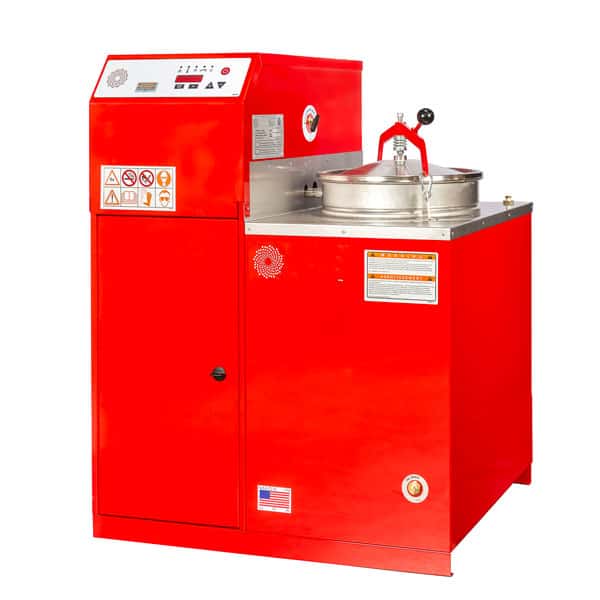Why Use a Solvent Recovery System?
Solvent recyclers remove soils, debris and oils from used cleaning solvent through distillation, and allow for reuse of the cleaning solvent. A solvent recovery system for used solvents can reduce solvent purchases by over 95% and reduce chemical waste disposal cost by over 90%.
For solvent processes like vapor degreasing, chemical disposal can be unexpectedly expensive. A solvent recycler machine not only reduces chemical disposal costs, but also new solvent purchases. Solvent recovery equipment can recycle and recover most solvents, including:
- Mineral spirits
- Paint Thinner
- Acetone
- IPA (isopropyl alcohol)
- MEK (methyl ethyl ketone)
- Xylene
- Hexane
- Various alcohols
- Chlorinated solvents (AK225, 1,2 trans-dichloroethylene / trans DCE, 3M™ Novec™, Dupont Vertrel)
- Microcare solvents
- Terpenes Toluene
- Aromatic Solvents
In addition, Class 1 Division 1 NFPA solvent recyclers can be used to ensure safety for flammable solvents.
Solvent Recovery Machine – 6-Gallon capacity
Solvent recycling equipment can recycle nearly any solvent or chemistry used in electroplating, metal finishing, paint and powder coating, parts washing, and vapor degreasing.
How Does a Solvent Recovery System Work?
Solvent recovery systems use the process of distillation, which separates volatile and nonvolatile solutions in a solvent. The solution is boiled and the vapors are condensed back into liquid in a separate tank, very similar to how a vapor degreaser works. The various constituents of the solvent and contaminants each boil at different temperatures: typically oils and soils are much higher than solvents. A good example of this is paint thinner which is used to clean paint off paint guns and parts; the solvent boils at a much lower temperature than paint, so boiling the mix will result in condensed pure solvent in one tank and paint sludge components in another tank. A solvent recycling machine is also sometimes called a paint thinner recycler.
Simple vs. Fractional Distillation and How to Separate Multiple Solvents
The above description and solvent recycling example is of simple distillation which aims to separate one solvent in solution and recovers the majority of the solvent in solution. Simple distillation entails condensing hot boiled vapors directly from the boiling tank of the solvent recycler. Because the condensing occurs directly near the boil “sump,” only one volatile solvent can be recovered and the purity of the solvent may contain very small amounts of non-volatile contaminants carried with the boiling, volatile vapors. This is the same process used by vapor degreasers. While recovery of a single volatile solvent can reach 99%+, there are times when higher recoveries are necessary.
When higher purity recovery or two or more volatile components (ie. water and isopropyl alcohol) require separation, fractional distillation is required. Fractional distillation uses a reflux column between the boiling tank and the condenser coils to achieve higher purity solvent recovery and separation of different volatile solvents. This process can achieve 99% solvent recovery and solvent purities of over 99.9%, often required for electronic / PCB manufacturing, medical device and aerospace applications.
Best Technology does not currently offer fractional distillation in solvent recyclers. Our solvent recycling systems feature simple distillation.
Paint Thinner Recycler System – 17.5-Gallon capacity
Vacuum Assisted Distillation
Putting a vacuum on the distillation column and chamber can be required for higher boiling and heavier-than-air (higher vapor density than 29 AMU – atomic mass units) solvents such as xylenes, CFCs, etc. vs. lighter-than-air acetones, MEK (Methyl ethyl ketone / butanone), MPK (Methyl n-Propyl Ketone), alcohols, etc.
Used Solvent Recovery System and Recycling Waste Solvent Benefits
- Reduce virgin solvent purchases
- Reduce solvent chemical waste
- Reduce effects on hazardous waste generator permit status
- Lower storage costs
- Obtain quicker ROI on capital equipment when using safer yet more expensive engineered solvents like Dupont Vertrel or 3M™ Novec™ engineered fluids.
Solvent Recovery System – 55-Gallon capacity
Inline Vapor Degreaser Integration
While vapor degreasers inherently distill solvents, further distillation of just the vapor degreaser boil sump can extend the life and reduce consumption of solvents. Automated integration of a solvent recovery system with a vapor degreaser is typically very simple, with no vapor degreaser modifications: pull from the drain of the boil sump and exit distilled solvents into the rinse sump or water separator. Waste is then stored in the solvent recycler for easy disposal. This permits continuous use of the degreaser without down time to clean the boil sump. With solvent recovery systems, solvent boil down and change-out intervals can be increased by 200%.
Solvent recycling machines and solvent recovery systems can greatly reduce costs, hazardous waste disposal, and solvent consumption while increasing process stability and operation.
Ready to start your solvent recovery project? To learn more about solvent recovery systems, contact a solvent recycling expert at Best Technology today.



